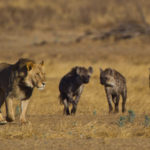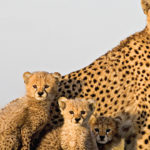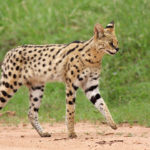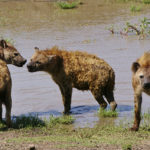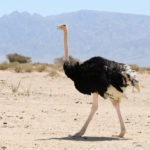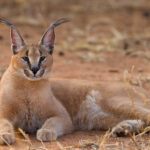Cheetahs – information
 Because of the lack of sharp claws, cheetahs can not climb trees like all cats, and can not hide prey in the branches. This greatly complicates their lives, because such successful hunters attract “unscrupulous competitors” in the face of hyenas, lions and leopards. Larger predators will not fail to take advantage of the donated prey of cheetahs. Cheetahs are inferior to them in force, besides they are very vulnerable to the slightest trauma (after all, it’s impossible to race with a booted paw), so they never get involved in a fight.
Because of the lack of sharp claws, cheetahs can not climb trees like all cats, and can not hide prey in the branches. This greatly complicates their lives, because such successful hunters attract “unscrupulous competitors” in the face of hyenas, lions and leopards. Larger predators will not fail to take advantage of the donated prey of cheetahs. Cheetahs are inferior to them in force, besides they are very vulnerable to the slightest trauma (after all, it’s impossible to race with a booted paw), so they never get involved in a fight.
During the breeding season, male cheetahs compete with each other for the right to enter the territory of the female. Pregnancy lasts 3 months. The female gives birth in a secluded place 2-4 kittens. Externally, the kids are very different from adults: their hair is gray and very long.
Such caution is not superfluous, because large predators can find and kill cubs. The female feeds the babies with milk for up to 8 months, and then begins to bring them the wounded animals. On such podrankah young cheetahs practice hunting techniques.
Cheetahs, though dexterous predators, but weak animals. Mortality among young animals reaches 70%. The main enemies of cheetahs is the “formidable trinity” – lions, hyenas and leopards, who attack young animals and take prey from adults. In addition, cheetahs can be injured on the hunt from larger animals – wildebeest, zebras, warthogs. In this case, even relatively small damages become critical, because cheetahs do not get food by cunning, but thanks to their excellent sports form.
For a human cheetah is not an important object of hunting: because of the short fur, the cheetah’s skin loses value to other types of felines. In the old days people often hunted not on cheetahs, but with cheetahs. Easily tamed cheetahs used to hunt gazelles as greyhounds. Such “packs” existed among the Central Asian khans and Indian rajas. Natachannye animals were of great value, but they did not receive wide distribution.
The fact is that cheetahs are heat-loving animals and do not tolerate dampness and low temperatures. Unlike other cats, they do not adapt well to the new conditions of detention, and in captivity they hardly breed. Because of the specific way of life, these animals need large areas and the availability of suitable prey, so in populous Asian countries they were driven out of their habitats by humans. Individual animals have survived only in the remote parts of the Iranian deserts, but they are threatened with destruction.
